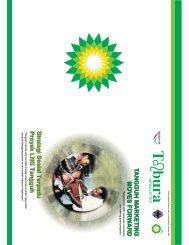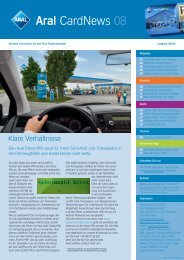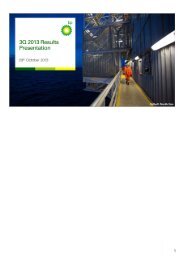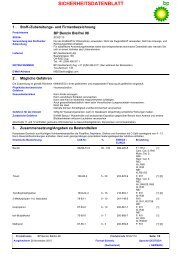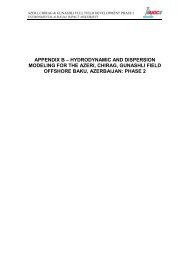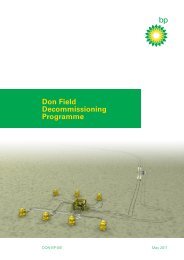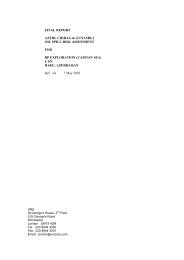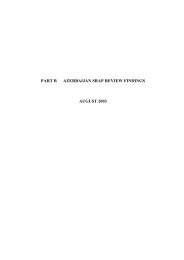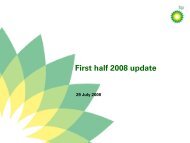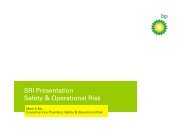Protocols for Welcome to Country and Acknowledgement of ... - BP
Protocols for Welcome to Country and Acknowledgement of ... - BP
Protocols for Welcome to Country and Acknowledgement of ... - BP
Create successful ePaper yourself
Turn your PDF publications into a flip-book with our unique Google optimized e-Paper software.
<strong>Pro<strong>to</strong>cols</strong> <strong>for</strong> <strong>Welcome</strong> <strong>to</strong> <strong>Country</strong><strong>and</strong> <strong>Acknowledgement</strong> <strong>of</strong>Traditional Ownership
What is a <strong>Welcome</strong> <strong>to</strong> <strong>Country</strong>?A <strong>Welcome</strong> <strong>to</strong> <strong>Country</strong> is where an Aboriginal or Torres Strait Isl<strong>and</strong>ercus<strong>to</strong>dian or elder from the local area or region welcome people <strong>to</strong> their l<strong>and</strong>.<strong>Welcome</strong> <strong>to</strong> <strong>Country</strong> always occurs at the opening <strong>of</strong> an event <strong>and</strong> is usuallythe first item on the program.The local Aboriginal/Torres Strait cus<strong>to</strong>dians or traditional owners conduct theceremony <strong>and</strong> may be done through speech, song, ceremony or a combination<strong>of</strong> these things.Why do we arrange a <strong>Welcome</strong> <strong>to</strong> <strong>Country</strong>?Arranging a <strong>Welcome</strong> <strong>to</strong> <strong>Country</strong> ceremony thatacknowledges the traditional cus<strong>to</strong>dians <strong>of</strong> the l<strong>and</strong> showsrespect <strong>for</strong> Aboriginal <strong>and</strong> Torres Strait Isl<strong>and</strong>er people asAustralia’s First Peoples. Ceremonies <strong>and</strong> pro<strong>to</strong>cols are afundamental part <strong>of</strong> Aboriginal culture.We do this <strong>to</strong> increase the underst<strong>and</strong>ing <strong>and</strong> mutualrespect <strong>for</strong> cultural practices by Aboriginal <strong>and</strong> TorresStrait Isl<strong>and</strong>ers <strong>and</strong> the wider community.When would we do a <strong>Welcome</strong> <strong>to</strong> <strong>Country</strong>?A <strong>Welcome</strong> <strong>to</strong> <strong>Country</strong> is appropriate in thoseinstances where:• There is a large gathering <strong>of</strong> people (300+) <strong>and</strong>/or• There is an event <strong>to</strong> celebrate/mark (eg. A new buildingopening)How do we arrange <strong>for</strong> a <strong>Welcome</strong> <strong>to</strong> <strong>Country</strong>?If you would like <strong>to</strong> organise a <strong>Welcome</strong> <strong>to</strong> <strong>Country</strong> <strong>for</strong> anevent, please refer <strong>to</strong> the Traditional Owner fact sheetsfound under the RAP collateral section <strong>of</strong> <strong>BP</strong>’s intranetOr click here.W331949 PROTOCOLS FOR WELCOME TO COUNTRY AND ACKNOWLEDGEMENT OF TRADITIONAL OWNERSHIP2
Things <strong>to</strong> consider be<strong>for</strong>e arranging <strong>for</strong> a<strong>Welcome</strong> <strong>to</strong> <strong>Country</strong>Event organisers need <strong>to</strong> ensure that the traditionalowners <strong>of</strong> the l<strong>and</strong> are involved in the <strong>Welcome</strong> <strong>to</strong> <strong>Country</strong>ceremony. This is a right <strong>of</strong> the local traditional owners <strong>and</strong>is not a privilege.It is important <strong>to</strong> invite local Aboriginal/Torres Strait Isl<strong>and</strong>errepresentatives in<strong>to</strong> any planned proposal at the outset <strong>to</strong>discuss <strong>and</strong> decide:• The <strong>for</strong>mat <strong>of</strong> the ceremony• Who should be invited• Who should per<strong>for</strong>m the <strong>Welcome</strong> <strong>to</strong> <strong>Country</strong> <strong>and</strong>• How that person will be recognised <strong>for</strong> their time<strong>and</strong> commitment.Observing Aboriginal/Torres Strait Isl<strong>and</strong>er pro<strong>to</strong>colincludes allowing time <strong>for</strong> traditional decision-making<strong>and</strong> discussion amongst traditional cus<strong>to</strong>dians. Thiscan take some time <strong>and</strong> should be fac<strong>to</strong>red in<strong>to</strong> theplanning process.There is usually also a cost associated with per<strong>for</strong>minga <strong>Welcome</strong> <strong>to</strong> <strong>Country</strong>, which should also be considered.This cost can vary depending on regions.Responding <strong>to</strong> a <strong>Welcome</strong> <strong>to</strong> <strong>Country</strong>It is necessary <strong>for</strong> the speaker who follows immediatelyafter the <strong>Welcome</strong> <strong>to</strong> <strong>Country</strong> ceremony <strong>to</strong> providea response.Part <strong>of</strong> the response should acknowledge the person whodelivered the <strong>Welcome</strong> <strong>to</strong> <strong>Country</strong>. If the cus<strong>to</strong>dians <strong>of</strong> thel<strong>and</strong> are not the traditional owners, it may be necessary <strong>to</strong>acknowledge both groups.The following text can be used in response <strong>to</strong> thetraditional <strong>Welcome</strong> <strong>to</strong> <strong>Country</strong>:We respectfully acknowledge the past <strong>and</strong> presenttraditional owners <strong>of</strong> this l<strong>and</strong> on which we aremeeting, the people. It isa privilege <strong>to</strong> be st<strong>and</strong>ing on country.The following text could be used if the cus<strong>to</strong>dians are notthe traditional owners:I respectfully acknowledge the past <strong>and</strong> presenttraditional owners <strong>of</strong> the l<strong>and</strong> on which we st<strong>and</strong> the people <strong>and</strong> the peoplewho are the cus<strong>to</strong>dians.W331949 PROTOCOLS FOR WELCOME TO COUNTRY AND ACKNOWLEDGEMENT OF TRADITIONAL OWNERSHIP3
<strong>Acknowledgement</strong> <strong>of</strong> <strong>Country</strong>What is an <strong>Acknowledgement</strong> <strong>of</strong> <strong>Country</strong>?An <strong>Acknowledgement</strong> <strong>of</strong> <strong>Country</strong> is a way <strong>for</strong> the widercommunity <strong>to</strong> demonstrate respect <strong>for</strong> Aboriginal pro<strong>to</strong>col,<strong>and</strong> can be per<strong>for</strong>med by any individual – Indigenous ornon-Indigenous, at any occasion.How does it differ from a <strong>Welcome</strong><strong>to</strong> <strong>Country</strong>?• An acknowledgement <strong>of</strong> <strong>Country</strong> can be conducted by anon-Indigenous person, whereas a <strong>Welcome</strong> <strong>to</strong> <strong>Country</strong>can only be conducted by select Indigenous persons.• An acknowledgement <strong>of</strong> <strong>Country</strong> consists <strong>of</strong> justspoken word, whereas a <strong>Welcome</strong> <strong>to</strong> <strong>Country</strong> maybe a combination <strong>of</strong> song, dance <strong>and</strong>/or speech.• There is no cost <strong>to</strong> conduct an Acknowledgemen<strong>to</strong>f <strong>Country</strong>.When would we do an Acknowledgemen<strong>to</strong>f <strong>Country</strong>?There may be some events/gatherings where it is notappropriate or possible <strong>to</strong> do a <strong>Welcome</strong> <strong>to</strong> <strong>Country</strong>.These include when:• The nature <strong>of</strong> the event is <strong>to</strong>o small or not consideredimportant enough <strong>to</strong> warrant a <strong>Welcome</strong> <strong>to</strong> <strong>Country</strong>(eg. Meetings, Townhalls)• Organisers are not able <strong>to</strong> make suitable arrangementwith the traditional l<strong>and</strong> owners (eg. Prohibitive costs,not enough time <strong>to</strong> discuss requirements)• Traditional owners cannot per<strong>for</strong>m a <strong>Welcome</strong> <strong>to</strong><strong>Country</strong> because <strong>of</strong> personal reasons <strong>and</strong>/or culturalbusiness.In these circumstances it is important that a seniormanager acknowledges the traditional owners <strong>of</strong> the l<strong>and</strong>in an appropriate way.As a suggested measure, where the gathering consists<strong>of</strong> >50 people, there should be an Acknowledgemen<strong>to</strong>f <strong>Country</strong>.What do you say <strong>to</strong> Acknowledge <strong>Country</strong>– if you know the traditional ownersI respectfully acknowledge the past <strong>and</strong> present traditionalowners <strong>of</strong> this l<strong>and</strong> on which we are meeting, the people. It is a privilege <strong>to</strong> be st<strong>and</strong>ingon country.What do you say <strong>to</strong> Acknowledge <strong>Country</strong>– if you don’t know the traditional ownersI respectfully acknowledge the past <strong>and</strong> present traditionalowners <strong>of</strong> this l<strong>and</strong> on which we are meeting.How do you find out who are the traditionalcus<strong>to</strong>dians <strong>of</strong> the l<strong>and</strong> in your area?Please refer <strong>to</strong> the Traditional Owner fact sheets foundunder the RAP collateral section <strong>of</strong> <strong>BP</strong>’s intranet orclick here.W331949 PROTOCOLS FOR WELCOME TO COUNTRY AND ACKNOWLEDGEMENT OF TRADITIONAL OWNERSHIP4
How many people willbe present at the event?If more than 150+If less than 150Has a <strong>Welcome</strong> <strong>to</strong> countrybeen per<strong>for</strong>med at a similarevent be<strong>for</strong>e?INTERNAL EVENTIf internal only <strong>and</strong> >50 then anAcknowledgment <strong>of</strong> <strong>Country</strong>would be appropriate.Please refer <strong>to</strong> <strong>Welcome</strong><strong>to</strong> <strong>Country</strong> pro<strong>to</strong>col <strong>for</strong>appropriate wording.EXTERNAL EVENTIf External – Will there beGovernment or Aboriginal/Torres Strait Isl<strong>and</strong>errepresentatives present?YesNoYesNoA <strong>Welcome</strong> <strong>to</strong>A <strong>Welcome</strong> <strong>to</strong>A <strong>Welcome</strong> <strong>to</strong> countryis not required.<strong>Country</strong> may beappropriate pleaserefer <strong>to</strong> the TraditionalOwner fact sheetsfound under theRAP collateral section<strong>of</strong> <strong>BP</strong>’s intranet or<strong>Country</strong> may beappropriate pleaserefer <strong>to</strong> the TraditionalOwner fact sheetsfound under theRAP collateral section<strong>of</strong> <strong>BP</strong>’s intranet orAn Acknowledgmen<strong>to</strong>f <strong>Country</strong> may bemore suitable. Pleaserefer <strong>to</strong> <strong>Welcome</strong> <strong>to</strong><strong>Country</strong> pro<strong>to</strong>col <strong>for</strong>appropriate wording.click here.click here.W331949 PROTOCOLS FOR WELCOME TO COUNTRY AND ACKNOWLEDGEMENT OF TRADITIONAL OWNERSHIP5
Largs (City <strong>of</strong> Port Adelaide Enfield)The Largs Bay area <strong>and</strong> the greater City <strong>of</strong> Port Adelaide Enfield comprise terri<strong>to</strong>ry which is the traditional l<strong>and</strong> <strong>of</strong>the Kaurna people. Kaurna <strong>Country</strong> (Kaurna Yerta) extends north <strong>to</strong>wards Crystal Brook, down the Adelaide plains,south along the coast <strong>to</strong> Cape Jervis <strong>and</strong> is bounded by the Mount L<strong>of</strong>ty Ranges <strong>to</strong> the east.For in<strong>for</strong>mation in regard <strong>to</strong> conducting <strong>Welcome</strong> <strong>to</strong> <strong>Country</strong> ceremonies <strong>for</strong> events <strong>and</strong> gatherings, or<strong>Acknowledgement</strong> <strong>of</strong> <strong>Country</strong>, follow this link: http://www.adelaide.edu.au/policies/670/For contact with local groups who may be able <strong>to</strong> per<strong>for</strong>m <strong>Welcome</strong> <strong>to</strong> <strong>Country</strong> ceremonies, contact:Kura Yerlo Inc208 Lady Gowrie DrLargs Bay S.A. 5016P.O. Box 203Port Adelaide 5015Phone: (08) 8449 7367Fax: (08) 8341 7006Email: reception@kurayerloinc.org.auCity <strong>of</strong> Port Adelaide Enfield163 St Vincent Street, Port Adelaide SA 5015PO Box 110 Port Adelaide SA 5015Ph: (08) 8405 6600 | (08) 8405 6666E: custserv@portenf.sa.gov.au | W: www.portenf.sa.gov.auKurruru Youth Per<strong>for</strong>ming Arts135 St Vincent StPort Adelaide SA 5015Ph: (08) 8341 1150Other local networks:Port Adelaide Primary Health Care CentreCnr Church & Dale St, Port Adelaide SA 5015Ph: (08) 8240 9611Uniting Care Wesley Port Adelaide Inc.70 Dale St, Port Adelaide SA 5015Ph: (08) 8241 0211Tauondi Aboriginal Community College Inc.1 Lipson Street, Port Adelaide SA 5015PO Box 409 Port Adelaide SA 5015Ph: (08) 8240 0300 | Fax: (08) 8240 0786Culture (local knowledge):It was recognised that amongst Indigenous people, family relationships, cultural practices <strong>and</strong> traditions, spiritualrituals <strong>and</strong> beliefs, <strong>and</strong> social constructs <strong>and</strong> teachings, were intimately tied <strong>and</strong> connected <strong>to</strong> l<strong>and</strong>, not only <strong>to</strong> aplace <strong>of</strong> birth <strong>and</strong> its environs but also <strong>to</strong> the ‘dreaming’ places <strong>and</strong> tracks <strong>of</strong> ancestral spirits. ‘Dreaming’ s<strong>to</strong>ries <strong>and</strong>language constituted reality <strong>for</strong> the local Kaurna people <strong>and</strong> <strong>to</strong> this day, these s<strong>to</strong>ries are important in recognisingIndigenous cultural heritage <strong>and</strong> reasserting it within the l<strong>and</strong>scape.There was an interconnectedness between Indigenous people <strong>and</strong> their l<strong>and</strong>, their ances<strong>to</strong>rs, their spiritualances<strong>to</strong>rs, their knowledge <strong>and</strong> s<strong>to</strong>ries, their practices, <strong>and</strong> their families. In particular, the ‘sacredness’ <strong>of</strong> siteswas misunders<strong>to</strong>od because Indigenous mythology <strong>and</strong> its influence on Kaurna cultural practices was an intangibleconcept. As a result, there was little recognition <strong>of</strong> the manner in which Kaurna people learnt, how they saw the l<strong>and</strong>as their ‘University’ that their people.The various Kaurna Aboriginal groups had a well-established pattern <strong>of</strong> occupation. During the summer they rangedfreely within recognised l<strong>and</strong> owning boundaries, generally favouring the dunes <strong>and</strong> coastal areas where they couldlive satisfac<strong>to</strong>rily <strong>of</strong>f a wide range <strong>of</strong> fish <strong>and</strong> shellfish while extensive marshes adjacent <strong>to</strong> the coast teemed withwater birds <strong>of</strong> many species. Marsupials <strong>of</strong> all sizes were plentiful <strong>and</strong> in addition there were extensive vegetablefood sources, many <strong>of</strong> which are now extinct.Traditional foods includes possum, kangaroo, emu eggs, qu<strong>and</strong>ong, bush turkey, acacia seeds <strong>and</strong> gum, fish <strong>and</strong>W292782
Largs (City <strong>of</strong> Port Adelaide Enfield)shellfish, witchetty grubs, ducks <strong>and</strong> other birds <strong>and</strong> seeds <strong>for</strong> flour. Young men wear black cocka<strong>to</strong>o feathers in theirhair when dressed <strong>for</strong> ceremony. Nets are used <strong>to</strong> catching ducks <strong>and</strong> fish. Wooden implements are used <strong>for</strong> digging<strong>and</strong> throwing <strong>and</strong> wooden bowls are used <strong>for</strong> water <strong>and</strong> seed collecting.The Social structure <strong>of</strong> the Kaurna appeared <strong>to</strong> have followed the classic cellular pattern <strong>of</strong> Aboriginal society. Thetribe was a group that enjoyed a common language - with some regional dialects - <strong>and</strong> experienced a strong sense <strong>of</strong>belonging <strong>to</strong> a distinct social group, within a well- defined geographical boundary.Areas <strong>of</strong> particular note within the Port Adelaide Enfield region include:Gillman Dune: Now almost entirely levelled or developed, <strong>of</strong>fered elevated locations extending well in<strong>to</strong> the low lying,food prone environments surrounding the southern edge <strong>of</strong> the estuary. The strategic importance <strong>of</strong> this feature isillustrated in the number <strong>of</strong> sites found along its length including camps that were maintained well in<strong>to</strong> his<strong>to</strong>ric timesin <strong>and</strong> around Port Adelaide/Yertabulti.Gepps Cross – Dry Creek area: The discovery <strong>of</strong> several skulls aligning the Kilburn dunes near Gepps Cross wasreported in The Adelaide Observer 1/8/1868 with the article noting that the area was a well-known fighting ground’<strong>and</strong> skele<strong>to</strong>ns <strong>and</strong> implements had been found throughout the area on previous occasions.Rosewater – Queens<strong>to</strong>wn area: A number <strong>of</strong> sites (burials <strong>and</strong> a ceremonial ground) have been recorded in the areaaligning along the Rosewater dunes. A shallow waterhole located in the area had been used by Aboriginals <strong>to</strong>getherwith the local settlers <strong>and</strong> teamsters carting ore from Burra <strong>to</strong> Port Adelaide/Yertabulti. The locality <strong>of</strong> the waterholewas later called ‘Rosewater’ <strong>for</strong> its high quality water.His<strong>to</strong>ry:The arrival <strong>of</strong> the British settlers soon disrupted the balance achieved between the Kaurna <strong>and</strong> T<strong>and</strong>anya. The Kaurnaway <strong>of</strong> life that relied on mobility within their defined terri<strong>to</strong>ry was in direct conflict with the Europeans’ plans <strong>to</strong>survey <strong>and</strong> sell their l<strong>and</strong>. Within twenty years, many Kaurna had died from illnesses <strong>and</strong> diseases introduced by thesettlers. The survivors were transported <strong>to</strong> a native settlement at Poonindie, near Port Lincoln on the Eyre Peninsula,well outside Kaurna terri<strong>to</strong>ry. Only since the 1960s have some people <strong>of</strong> Kaurna descent started <strong>to</strong> come back <strong>to</strong>Adelaide <strong>to</strong> live.Sources <strong>and</strong> further reading:www.portenf.sa.gov.au/webdata/resources/files/Final_Report_August_2007.pdfwww.his<strong>to</strong>ry.sa.gov.au/his<strong>to</strong>ry/adelaide_his<strong>to</strong>ry/adelaide_brief_his<strong>to</strong>ry.pdfwww.sea<strong>for</strong>drisecc.sa.edu.au/kaurna_tjilbruke.htmwww.portenf.sa.gov.au/webdata/resources/files/Final_Report_August_2007.pdfwww.kaurnaplacenames.comW292782
KwinanaTraditional Owners <strong>and</strong> Local NetworksThe Town <strong>of</strong> Kwinana is situated on l<strong>and</strong> which was inhabited by the Whadjuk Nyoongar people <strong>for</strong> over 40,000years.For in<strong>for</strong>mation <strong>and</strong> pro<strong>to</strong>cols in regard <strong>to</strong> conducting <strong>Welcome</strong> <strong>to</strong> <strong>Country</strong> ceremonies or <strong>Acknowledgement</strong> <strong>of</strong><strong>Country</strong> <strong>for</strong> events <strong>and</strong> gatherings, please follow this link: http://www.noongar.org.au/images/pdf/<strong>for</strong>ms/BookTwo-Pro<strong>to</strong>colGuide16p.pdfFor contact with local groups who may be able <strong>to</strong> per<strong>for</strong>m <strong>Welcome</strong> <strong>to</strong> <strong>Country</strong> ceremonies, contact:Town <strong>of</strong> KwinanaPO Box 21, Kwinana WA 6966Cnr Gilmore Avenue <strong>and</strong> Sulphur Road,Kwinana WA 6167Ph: (08) 9439 0200 | Fax: (08) 9439 0222E: admin@kwinana.wa.gov.au | W: www.kwinana.wa.gov.auMoorditj Koort Aboriginal Health & WellnessCentre Kwinana & Rockingham150 Gilmore AvenueMedina WA 6167Ph: (08) 9439 9540Fax: (08) 9439 6288www.rkdgp.com.au/site/index.cfmOther Local Networks:Bridging the GapUnit 24B, Kwinana Commercial Centre, 43 Meares Av,Kwinana WA 6167Ph: (08) 9419 2553 | Fax: (08) 9439 2552E: mailbox@bridgingthegap.org.au | W: www.bridgingthegap.org.auNanakaat Aboriginal Family SupportHutchins Cove (rear <strong>of</strong> TAFE), Kwinana WA 6167Ph: (08) 9419 0417 | Fax: (08) 9439 0272E: nanakaat@kwinana.wa.gov.au | W: www.kwinana.wa.gov.auKwinana Community Health & Development Centre1 Peel Ct, Kwinana WA 6167Ph: (08) 9419 2266 | Fax: (08) 9439 1088Parent <strong>and</strong> Adolescent Counselling Service1 Peel Ct, Kwinana WA 6167Ph: (08) 9528 0702 | Fax: (08) 9528 0755E: rebecca.henderson@anglicarewa.org.au | W:www.anglicarewa.org.auCulture (local knowledge):The Aboriginal peoples <strong>of</strong> the Kwinana area are part <strong>of</strong> the Nyoongar people. Nyoongar people traditionally lived anomadic hunter-gatherer lifestyle, travelling <strong>to</strong> <strong>and</strong> from destinations <strong>and</strong> meeting areas throughout the seasons.Wetl<strong>and</strong>s have great spiritual significance <strong>to</strong> Aboriginal people. They were also sources <strong>of</strong> abundant food <strong>and</strong> freshwater <strong>and</strong> were <strong>of</strong>ten used as camp sites. Nyoongar family groups usually moved through the south-west l<strong>and</strong>scapein a set pattern, within a designated tract <strong>of</strong> terri<strong>to</strong>ry, <strong>of</strong>ten following fresh water sources.The Swan River Nyoongars described the coastal region south <strong>of</strong> Perth in geological divisions. Booyeembara, theportion along the coast, consisted principally <strong>of</strong> limes<strong>to</strong>ne rock, <strong>and</strong> generally supported the Xanthorea, <strong>and</strong> a fewspecies <strong>of</strong> eucalyptus such as Tuart, Pricklybark <strong>and</strong> Flooded Gum. Running parallel <strong>to</strong>, <strong>and</strong> behind this division wasG<strong>and</strong>oo, a s<strong>and</strong>y terrain rich in Jarrah <strong>and</strong> Marri. Warget, the division behind <strong>and</strong> parallel <strong>to</strong> G<strong>and</strong>oo, stretched alongthe foothills <strong>of</strong> the Darling Range.The Spectacles Wetl<strong>and</strong>s area is a significant site <strong>for</strong> Aboriginal people. The wetl<strong>and</strong>s is a part <strong>of</strong> the indigenousterri<strong>to</strong>ry known as the Beeliar Nation <strong>and</strong> is identified as the area <strong>of</strong> tribal elder Midgegooroo. Midgegooroo <strong>and</strong>his people were transitional <strong>and</strong>, like their ances<strong>to</strong>rs, moved within the Beeliar terri<strong>to</strong>ry according <strong>to</strong> the particularseason. The Spectacles Wetl<strong>and</strong>s is part <strong>of</strong> the major <strong>and</strong> ancient trade route that follows the freshwater lakeslinking the Aboriginal peoples <strong>of</strong> the Murray <strong>and</strong> Swan rivers.W292782
KwinanaThe area has cultural significance as a ceremonial, camping <strong>and</strong> food gathering site. Kwinana has a rich Aboriginalheritage <strong>and</strong> is the second largest indigenous community in the Perth metropolitan area.Seventeen significant Nyoongar places in the City <strong>of</strong> Kwinana have been listed on the Register <strong>of</strong> Aboriginal Sitesestablished by the Department <strong>of</strong> Indigenous Affairs. The largest number <strong>of</strong> places <strong>of</strong> Aboriginal significance inKwinana are artefact sites – including finds at Woolcoot Road Swamp, Treeby Road Lake, Mortimer, Bellway S<strong>and</strong>Quarry, Chalk Hill camps, Bertram Road, Norkett Road, Sloans reserve, Wally’s camp, Thomas Oval, Hope Valley <strong>and</strong>Leda. Mythological sites have been registered at M<strong>and</strong>ogalup (Spectacles) <strong>and</strong> Mount Brown (Booyeeanup).The lakes <strong>of</strong> Beeliar Regional Park are also important as spiritual <strong>and</strong> mythological locations. The spiritual connectionbetween the Aboriginal community <strong>and</strong> North <strong>and</strong> Bibra Lakes continues <strong>to</strong>day.His<strong>to</strong>ry:In the Whadjuk (Nyoongar) Indigenous language the word Kwinana means ‘Pretty Maiden’.Some knowledge <strong>of</strong> groups occupying the l<strong>and</strong> south <strong>of</strong> the Swan River can be derived from the investigations<strong>of</strong> early European settlers, as no his<strong>to</strong>rical records made by Aboriginal people have survived. In 1832, the earlysettler Robert Lyon, with the help <strong>of</strong> Yagan, then a prisoner on Carnac Isl<strong>and</strong>, compiled a list <strong>of</strong> Aboriginal groups incontact with the Swan River settlement. This in<strong>for</strong>mation was published in the Perth Gazette in 1833. Five yearslater, Francis Armstrong- who spoke five Nyoongar dialects- recorded the names <strong>of</strong> groups in the south-west <strong>of</strong>Western Australia. In 1834, the 21-year-old Armstrong had been placed in charge <strong>of</strong> the newly established AboriginalInstitution at the base <strong>of</strong> Mt Eliza. He was Chief Advisor on Aboriginal Affairs <strong>to</strong> Governors Stirling <strong>and</strong> Hutt; heserved as the Superintendent <strong>of</strong> the Native Institution between 1834 <strong>and</strong> 1838; the <strong>of</strong>ficial Interpreter <strong>for</strong> Aboriginesin the Courts; a teacher in the Perth Aboriginal School (1840-1845); <strong>and</strong> then became the Moral Superintendent <strong>to</strong>the Aboriginal prisoners on Rottnest Isl<strong>and</strong>. In 1871, he held the position <strong>of</strong> Government Interpreter <strong>to</strong> the NativeTribes <strong>of</strong> Western Australia.With the coming <strong>of</strong> European settlement in 1829, the way <strong>of</strong> life <strong>of</strong> the Nyoongars was irreversibly changed. By theend <strong>of</strong> that first year, the Aboriginal firing <strong>of</strong> the bush <strong>to</strong> flush out game <strong>and</strong> the raiding <strong>of</strong> farmer’s food s<strong>to</strong>cks hadroused strong settler opposition. The ensuing Nyoongar resistance <strong>to</strong> exp<strong>and</strong>ing settlement in the Swan River Colonyultimately proved futile, however. Apart from their inability <strong>to</strong> unify politically <strong>to</strong> organize effective resistance, theAborigines were disadvantaged by their reluctance <strong>to</strong> adopt the European technology <strong>of</strong> warfare.The basis <strong>of</strong> Nyoongar traditions was also undermined as Aborigines were drawn in<strong>to</strong> the political economy <strong>of</strong> settlersociety. As early as 1833, Aboriginal labour was employed in the fishing industry at M<strong>and</strong>urah. Towards the end <strong>of</strong>the second decade <strong>of</strong> settlement, the Nyoongar were also employed in a variety <strong>of</strong> other occupations. They foundwork in whaling operations on the beach as well as boats’ crew, as domestic servants, farm labourers, guides <strong>to</strong>surveyors <strong>and</strong> explorers, constables <strong>and</strong> trackers, <strong>and</strong> as mailmen. By 1848, estimates put the number <strong>of</strong> Aboriginesemployed by the colonists at 540.Other fac<strong>to</strong>rs impacting negatively on the Nyoongars included the loss <strong>of</strong> traditional food sources due <strong>to</strong> expansion <strong>of</strong>European settlement, <strong>and</strong> the devastating effect <strong>of</strong> diseases <strong>to</strong> which they had no natural immunity. In 1841, influenzakilled large numbers <strong>of</strong> Nyoongar children <strong>and</strong> the elderly. In 1848, a whooping cough epidemic had a further deadlyeffect on the Aboriginal population. A new influenza epidemic in 1851 also caused a large loss <strong>of</strong> life in Nyoongarcommunities. Major epidemics <strong>of</strong> measles <strong>and</strong> influenza caused further death <strong>and</strong> disability in the 1880s.By 1900, however, there was the start <strong>of</strong> a gradual increase in the part-Aboriginal population <strong>of</strong> the south-west <strong>of</strong>Western Australia. There was also a steady movement <strong>of</strong> Aboriginal groups from beyond the ‘circumcision line’in<strong>to</strong> the south-west area that was the traditional terri<strong>to</strong>ry <strong>of</strong> the Nyoongar. By the late 20th century, the Aboriginalpopulation <strong>of</strong> the south-west had begun <strong>to</strong> recover. So much so that now, in the 21st century, men, women <strong>and</strong>children claiming Nyoongar descent are again one <strong>of</strong> the largest identifiable Aboriginal populations in Australia.W292782Sources <strong>and</strong> further reading:www.kwinana.wa.gov.auwww.rockingham.wa.gov.auwww.melvillecity.com.au/environment/www.dia.wa.gov.au/AHIS/default.aspxwww.spectacles<strong>to</strong>urs.com.au
KewdaleTraditional Owners <strong>and</strong> Local NetworksKewdale is situated on l<strong>and</strong> which was inhabited by the Whadjuk, (also called Wajuk, Wadjuk, Whajook <strong>and</strong> Wadjug),who belonged <strong>to</strong> the greater South Western language group <strong>of</strong> Noongar Aboriginal peoples. The Whadjuk, had theirown distinctive dialect.For in<strong>for</strong>mation <strong>and</strong> pro<strong>to</strong>cols in regard <strong>to</strong> conducting <strong>Welcome</strong> <strong>to</strong> <strong>Country</strong> ceremonies or <strong>Acknowledgement</strong> <strong>of</strong><strong>Country</strong> <strong>for</strong> events <strong>and</strong> gatherings, please follow this link: http://www.noongar.org.au/images/pdf/<strong>for</strong>ms/BookTwo-Pro<strong>to</strong>colGuide16p.pdfFor contact with local groups who may be able <strong>to</strong> per<strong>for</strong>m <strong>Welcome</strong> <strong>to</strong> <strong>Country</strong> ceremonies, contact:City <strong>of</strong> BelmontLocked Bag 379 Cloverdale WA 6985215 Wright Street, Cloverdale WA 6105Ph: (08) 9477 7222 | Fax: (08) 9478 1473E: belmont@belmont.wa.gov.au | W: www.belmont.wa.gov.auJacar<strong>and</strong>a Community Centre146 Epsom Ave, Belmont WAPO Box 142, Cloverdale WA 6895Tel: 9477 4346 9478 1219E: info@jacar<strong>and</strong>acommunitycentre.org.auW: www.jacar<strong>and</strong>acommunitycentre.org.auOther local networks:Advocare1/190 Abernethy Rd, BelmontT: 9479 7566E: rights@advocare.org.auW: www.advocare.org.au/aap.phpBelmont Youth ServicesYouth Centre275 Abernethy Rd, BelmontT: 9477 7132 M: 0417 097 032Town Of Vic<strong>to</strong>ria Park Library27 Sussex St, East Vic<strong>to</strong>ria Park WA 6101Ph: (08) 9361 1977 | Fax: (08) 9470 5802E: library@vicpark.wa.gov.au | W: www.vicpark.wa.gov.auWestern Australian MuseumLocked Bag 49, Welshpool DC. WA 698649 Kew Street, Welshpool WA 6106Ph: (08) 9427 2859 | Fax: (08) 9212 3882E: reception@museum.wa.gov.au | W: www.museum.wa.gov.auCulture (local knowledge):The Nyoongar people <strong>of</strong> the Swan <strong>and</strong> Canning rivers were divided in<strong>to</strong> a number <strong>of</strong> different groups. Each group hadits own identified terri<strong>to</strong>ry <strong>and</strong> held specific cultural <strong>and</strong> hunting rights over particular stretches <strong>of</strong> the country. Thesystem <strong>of</strong> traditional ownership <strong>and</strong> associated special usage rights was far more complex than the current Europeansystem <strong>of</strong> l<strong>and</strong> ownership as Salvado’s observation’s state:“Every individual has his own terri<strong>to</strong>ry <strong>for</strong> hunting, gathering, gum <strong>and</strong> picking up yams, <strong>and</strong> the rights he has here arerespected <strong>and</strong> sacred .... Consequently, each family regards one particular district as belonging exclusively <strong>to</strong> itself,though the use <strong>of</strong> it is freely shared by nearby friendly families (Salvado, 1977).These terri<strong>to</strong>ry rights were inherited through complex kinship systems <strong>and</strong> although these may have altered due <strong>to</strong>the impacts <strong>of</strong> European occupation the spiritual association with l<strong>and</strong> that underpins this system continues <strong>to</strong> play amajor role <strong>for</strong> the local Nyoongar people <strong>to</strong>day.W292782
KewdaleNyoongar people traditionally lived a nomadic hunter-gatherer lifestyle, travelling <strong>to</strong> <strong>and</strong> from destinations <strong>and</strong>meeting areas throughout the seasons. Wetl<strong>and</strong>s have great spiritual significance <strong>to</strong> Aboriginal people. They werealso sources <strong>of</strong> abundant food <strong>and</strong> fresh water <strong>and</strong> were <strong>of</strong>ten used as camp sites. Nyoongar family groups usuallymoved through the south-west l<strong>and</strong>scape in a set pattern, within a designated tract <strong>of</strong> terri<strong>to</strong>ry, <strong>of</strong>ten following freshwater sources.Norman Tindale (1974) states the Whadjuk’s terri<strong>to</strong>ry as extending from the: ..“Swan River <strong>and</strong> northern <strong>and</strong> easterntributaries inl<strong>and</strong> <strong>to</strong> beyond Mount Helena; at Kalamunda, Armadale, Vic<strong>to</strong>ria Planes, South <strong>of</strong> Toodyay, <strong>and</strong> westernvicinity <strong>of</strong> York; at Perth; south along the coast <strong>to</strong> near Pinjarra”.His<strong>to</strong>ry:When the British settlers arrived at the Swan River in 1829 the country was already divided in<strong>to</strong> Indigenous familyterri<strong>to</strong>ries. Yellagonga’s l<strong>and</strong>, named Mooro, included Perth <strong>and</strong> the northern suburbs. Munday’s l<strong>and</strong>, ‘Beeloo’, wasbetween the Canning <strong>and</strong> Helena Rivers. Midgegooroo <strong>and</strong> his son Yagan held ‘Beeliar’, which included Fremantle<strong>and</strong> all the l<strong>and</strong> south <strong>to</strong> Rockingham. Both Munday <strong>and</strong> Yagan <strong>of</strong>fered strong resistance against colonisation <strong>of</strong> theirl<strong>and</strong>s.In 1830, the Hardey brothers Joseph <strong>and</strong> John arrived aboard the ‘Tranby’. John Hardey <strong>and</strong> his son Robert Daveywere destined <strong>to</strong> own practically the entire Belmont area. John Hardey called his new property on the Swan ‘GroveFarm’.The l<strong>and</strong> which come <strong>to</strong> be known as Belmont, is part <strong>of</strong> a l<strong>and</strong> grant assigned <strong>to</strong> Captain Francis Henry Byrne in1831, was believed <strong>to</strong> have been named Belmont after Byrne’s estate in Engl<strong>and</strong>.In 1832 Yagan was arrested <strong>for</strong> spearing William Gaze <strong>and</strong> would surely have been executed. A settler named RobertLyon argued that Yagan was acting in defence <strong>of</strong> his country <strong>and</strong> should not be hanged, but rather made a prisoner<strong>of</strong> war. This was accepted <strong>and</strong> Yagan with two companions, Dommera <strong>and</strong> Ningana, were removed under guard <strong>to</strong>Carnac Isl<strong>and</strong>, a few kilometres from the coast. Lyon went with Yagan <strong>and</strong> recorded in<strong>for</strong>mation about families <strong>and</strong>their terri<strong>to</strong>ries as well as the names <strong>of</strong> places, flora <strong>and</strong> fauna across what is now the Perth metropolitan area. Thiswas the first recording <strong>of</strong> the Nyoongar language.In Oc<strong>to</strong>ber 1832 Yagan escaped from Carnac Isl<strong>and</strong> <strong>and</strong> in July 1833 he was shot dead by William Keats, who wasthen fatally speared. Yagan’s body was mutilated, his preserved head placed on exhibit in Engl<strong>and</strong> in 1834. In 1997,Yagan’s remains were returned <strong>to</strong> Perth.Sources <strong>and</strong> further reading:www.swanrivertrust.wa.gov.auwww.vicpark.wa.gov.au/pdf/Package_K_3_FINAL.pdfwww.belmont.wa.gov.au/Services/Planning/Documents/2007 Municipal Heritage Inven<strong>to</strong>ry Intro.pdfW292782
HawthornThe Traditional Owners <strong>of</strong> the l<strong>and</strong> around present day Hawthorn are the Wurundjeri willam tribe, part <strong>of</strong> the WoiWurrung language group.For contact with local groups who may be able <strong>to</strong> per<strong>for</strong>m <strong>Welcome</strong> <strong>to</strong> <strong>Country</strong> ceremonies, contact:Wurundjeri Tribe L<strong>and</strong> & CompensationCultural Heritage Council IncorporatedPh: (03) 8673 09011 St Heliers StreetAbbots<strong>for</strong>d VIC 3067reception@wurundjeri.com.auOther local networks:City <strong>of</strong> BoroondaraPrivate Bag 1 Camberwell 3124 VIC8 Inglesby Road, Camberwell 3124 VICPh: (03) 9278 4444 | Fax: (03) 9278 4466E: boroondara@boroondara.vic.gov.au | W: www.boroondara.vic.gov.auBoroondara Volunteer Resource Centre405 Camberwell Road, Camberwell VIC 3124Ph: (03) 9278 4550Culture (local knowledge):As hunters <strong>and</strong> gatherers the Wurundjeri willam clan subsisted on the plants <strong>and</strong> animals within their clan estate.Their patterns <strong>of</strong> settlement were based on seasonal rounds following the changing availability <strong>of</strong> plant <strong>and</strong> animalresources. There are few his<strong>to</strong>ric details on traditional Woi wurrung subsistence <strong>for</strong> the language group as a whole.It is likely that Woi wurrung patterns <strong>of</strong> settlement <strong>and</strong> movement were based on seasonal rounds following thechanging availability <strong>of</strong> plant <strong>and</strong> animal resources. His<strong>to</strong>rical details on how animals were traditionally procured (thetechniques <strong>of</strong> hunting) <strong>and</strong> how <strong>and</strong> when plants were harvested are extremely poor <strong>for</strong> most <strong>of</strong> Aboriginal Vic<strong>to</strong>ria. Itis known that the Woi wurrung used spears <strong>to</strong> hunt <strong>and</strong> that hunters would hide behind vegetation or construct hides<strong>of</strong> s<strong>to</strong>ne.Nets were also used where game animals would be chased in<strong>to</strong> them.Certain foods were common including:• the Yam daisy or Murnong, the tuber <strong>of</strong> which was dug up by women;• bull-rush roots which were collected from waterways <strong>and</strong> roasted;• eels, which were a seasonal food caught in s<strong>to</strong>ne weirs <strong>and</strong> long fibre nets;• kangaroos <strong>and</strong> other smaller macropods which were hunted;• birds <strong>and</strong> their eggs;• possums - the fur <strong>of</strong> brush tail possums was used <strong>to</strong> make cloaks <strong>and</strong> the meat roasted.The Wurundjeri willam belonged <strong>to</strong> one <strong>of</strong> two moieties, named after the Dreamtime ances<strong>to</strong>rs, Bunjil (Eaglehawk)<strong>and</strong> Waa (Australian raven). Moiety affiliation was determined at birth with the child taking the moiety <strong>of</strong> the father’sclan. Kulin people were exogamous meaning they had <strong>to</strong> marry outside their clan, but also someone <strong>of</strong> the oppositemoiety.W292782
HawthornHis<strong>to</strong>ry:One <strong>of</strong> the first references by Europeans <strong>to</strong> Aboriginal people in the Boroondara area was made by James Fleming,a member <strong>of</strong> the survey party <strong>of</strong> Charles Grimes, which made its way up the Yarra in 1803. Fleming was <strong>to</strong> report onthe agricultural potential <strong>of</strong> the country:“Monday 7th (February 1803) - Early in the morning the party went up the river be<strong>for</strong>e with the doc<strong>to</strong>r, went up thelittle hill (Batman’s Hill) we had been at on the 4th, where we s<strong>to</strong>pped <strong>to</strong> breakfast. Proceeded <strong>to</strong> a creek (Gardiner’sCreek), where we dined. Saw some natives...”.Smith’s 1896 his<strong>to</strong>ry <strong>of</strong> Hawthorn records that John Gardiner, one <strong>of</strong> the earliest settlers in the Boroondara region,<strong>to</strong>ok up l<strong>and</strong> on the south side <strong>of</strong> the Yarra in 1837. Gardiner established his home at the junction <strong>of</strong> Gardiner’s Creek<strong>and</strong> the Yarra River, in the grounds <strong>of</strong> what is now Scotch College:“Pushing his way round the bank <strong>of</strong> the stream, he came <strong>to</strong> large creek upon which numbers <strong>of</strong> native wild fowl werefound, <strong>and</strong> here he settled. It was not long be<strong>for</strong>e the blacks found him out, <strong>and</strong> as he treated them well they becamefriendly. He asked them the name <strong>of</strong> the place <strong>and</strong> they said they called it “Boroondarra”, signifying “shady place”.He also asked them the name <strong>of</strong> the wild fowl on the creek, <strong>and</strong> they called these “Kooyongkoot”. He there<strong>for</strong>enamed the district Boroondara [...] while he called the stream the Kooyongkoot Creek. The <strong>for</strong>mer title has beenretained <strong>to</strong> this day, but the latter has been discarded, <strong>and</strong> the creek named after Gardiner himself” (Smith 1896: 8).Journalist <strong>of</strong> the day James Smith (1896) wrote <strong>of</strong> the local indigenous population:‘The tribe was one <strong>of</strong> the most powerful in the whole Port Phillip district, <strong>and</strong> ranged all over the country drained bythe Yarra Yarra. The portion called by them “Boroondara” was a favourite resting place <strong>for</strong> the tribe, <strong>and</strong> on <strong>to</strong>p <strong>of</strong> thehill now occupied by St. Xavier’s College at Kew they used <strong>to</strong> meet <strong>to</strong> hold periodical corroborees.’Sources <strong>and</strong> further reading:www.boroondara.vic.gov.au/our-city/arts-culture/indigenous/summaryW292782
Guild<strong>for</strong>dThe Traditional Owners <strong>of</strong> the l<strong>and</strong> around the present day Guild<strong>for</strong>d are the Bidjigal clan <strong>of</strong> the wider Darug tribalculture.For in<strong>for</strong>mation in regard <strong>to</strong> conducting <strong>Welcome</strong> <strong>to</strong> <strong>Country</strong> ceremonies <strong>for</strong> events <strong>and</strong> gatherings, please follow thislink http://www.holroyd.nsw.gov.au/wp-content/uploads/downloads/2012/08/<strong>Welcome</strong>-<strong>to</strong>-<strong>Country</strong>-Presentation.pdfFor contact with local groups who may be able <strong>to</strong> per<strong>for</strong>m <strong>Welcome</strong> <strong>to</strong> <strong>Country</strong> ceremonies, contact:Darug Research & In<strong>for</strong>mation Centre71 Seven Hills Road SouthSeven Hills NSW 2147Phone/Fax 02 96224081Email: info@dric.org.auDarug Tribal Aboriginal CorporationPO Box 441 Black<strong>to</strong>wn NSW 2148Phone 02 96224081Email: darug_tribal@live.com.auOther local networks:Parramatta City CouncilPO Box 32, Parramatta, NSW, 212430 Darcy Street, Parramatta, NSW, 2150Ph: (02) 9806 5050 | Fax: (02) 9806 5917E: council@parracity.nsw.gov.au | W: www.parracity.nsw.gov.auHolroyd City CouncilP.O. Box 42 Merryl<strong>and</strong>s, NSW 216016 Memorial Avenue, Merryl<strong>and</strong>s NSW 2160Ph: (02) 9840 9840 | Fax: (02) 9840 9734E: records@holroyd.nsw.gov.au | W: www.holroyd.nsw.gov.auMurangbai Aboriginal After Care ServiceSuite 2, Level 2/ 46 Macquarie St, ParramattaPh: (02) 9633 9211 or 1800 422 555NSW State L<strong>and</strong> CouncilPO Box 1125, Parramatta NSW 2124Ground Floor - 33 Argyle St,Parramatta NSW 2150Ph: (02) 9689 4444 | Fax: (02) 9687 1234E: www.alc.org.au/contact-us.aspx | W: www.alc.org.auIndigenous Disability Advocacy ServiceSuite 4, 2/6 Kendall St, Harris Park 2150Ph: (02) 9687 7688 | Fax: (02) 9806 5917E: idas@idas.org.au | W: www.idas.org.auJobfind Centre, Aboriginal Men<strong>to</strong>r Program6/20 Macquarie St, Parramatta NSW 2150Ph: (02) 8881 4900E: jobfind_Parramatta@jobfindcentre.com.au | W:www.jobfindcentre.com.auParramatta/Holroyd Family Support Inc.37 Collins Street, Pendle Hill NSW 2145Ph: (02) 9636 8437 | Fax: (02) 9896 3139E: phfs37@bigpond.net.au | W: www.phfs.org.auParramatta River Catchment GroupPO Box 3720, Parramatta NSW 21241st Floor, Macquarie Tower, 10 Valentine Ave,Parramatta NSW 2150Ph: (02) 9895 6253 | Fax: (02) 9895 7330E: prcgcoordina<strong>to</strong>r@cma.nsw.gov | W: www.parramattariver.org.auW292782
Guild<strong>for</strong>dCulture (local knowledge):Like all Aboriginal people, the Darug people did not own the l<strong>and</strong> but belonged <strong>to</strong> the l<strong>and</strong>. They had a strongconnection <strong>to</strong> the l<strong>and</strong>; respected it <strong>and</strong> referred <strong>to</strong> the l<strong>and</strong> as their mother. The Darug people had excellent l<strong>and</strong>management skills which meant they did not have <strong>to</strong> artificially cultivate crops. The Aboriginal population <strong>for</strong> theSydney region in 1788 has been estimated as being between 5000 <strong>and</strong> 8000 people, <strong>of</strong> which about 2000 belonged<strong>to</strong> the inl<strong>and</strong> Darug people. The Darug people were thought <strong>to</strong> have lived in b<strong>and</strong>s or communities <strong>of</strong> around 50members each. Each b<strong>and</strong> retained its own hunting district, <strong>and</strong> each lived a semi-nomadic lifestyle, regularlychanging location within this district.A <strong>to</strong>tem <strong>of</strong> the Darug people is the Warali Wal. Warali Wali is the Darug word <strong>for</strong> possum.One <strong>of</strong> the most distinctive features <strong>of</strong> pre-1788 Aboriginal Sydney was the cultural divide between the inl<strong>and</strong>paiendra “<strong>to</strong>mahawk people” who hunted game <strong>and</strong> used their s<strong>to</strong>ne axes <strong>to</strong> cut climbing marks on trees, <strong>and</strong> thekatungal “sea people” who were oriented <strong>to</strong>wards the seafood produce <strong>of</strong> the saltwater harbour, estuaries <strong>and</strong> oceanbeaches. The katungal people <strong>of</strong> the harbour <strong>and</strong> Botany Bay called themselves Eora (which meant “people <strong>of</strong> thisplace” or “people here”).His<strong>to</strong>ry:In April 1788 an expedition headed by Captain Arthur Phillip reached a location on the Parramatta river bridged byseries <strong>of</strong> broad flat s<strong>to</strong>nes where a freshwater stream flowed in<strong>to</strong> the tidal waters. Further along a crescent shapehad been carved in<strong>to</strong> the bank by the river’s action. Making his way <strong>to</strong> a nearby rise he later described the area as avast undulating grassl<strong>and</strong> interspersed with magnificent trees – a place ideal <strong>for</strong> a gaol <strong>to</strong>wn <strong>and</strong> farm. Exploring thearea the party was surprised <strong>to</strong> see traces <strong>of</strong> the Dharug people, <strong>and</strong> noted that the local people spoke the coastaldialect. Little did they know that the Burra-matta-gal l<strong>and</strong>s were a meeting point where <strong>for</strong> thous<strong>and</strong>s <strong>of</strong> years theinl<strong>and</strong> <strong>and</strong> coastal people fought ceremonial battles <strong>and</strong> held corroborees.The Bidjigal clan is inseparable from its leader Pemulwuy (a name derived from ‘bimul’ meaning ‘earth’) who, inDecember 1790, ambushed <strong>and</strong> fatally speared Governor Phillip’s game hunter, John McEntire. Samuel John Neeles’engraving <strong>of</strong> ‘Pimbloy’ is the only known image <strong>of</strong> Pemulwuy. ‘Theresemblance is thought <strong>to</strong> be striking by those who have seen him,’ wrote James Grant, captain <strong>of</strong> the sloop LadyNelson.Pemulwuy became a <strong>for</strong>midable resistance leader. In 1797, following a battle in Parramatta, he escaped afterhaving been filled with buckshot <strong>and</strong> was described as one that ‘No gun or pis<strong>to</strong>l can kill’. Governor King outlawedPemulwuy in 1801, <strong>of</strong>fering spirits <strong>and</strong> other rewards <strong>for</strong> his capture ‘dead or alive’.Pemulwuy was shot dead on 2 June 1802. He was decapitated <strong>and</strong> his head, preserved in spirits, was sent <strong>to</strong> SirJoseph Banks. Its whereabouts are unknown.Sources <strong>and</strong> <strong>for</strong> more in<strong>for</strong>mation:www.holroyd.nsw.gov.auwww.discoverparramatta.com.auhttp://www.wollicreek.org.au/wp-content/wolliupload/panel02-traditional-owners.pdfwww.creativespirits.infohttp://k6.board<strong>of</strong>studies.nsw.edu.au/go/hsie/background-sheetswww.lawlink.nsw.gov.au/lrc.nsf/pages/RR7CHP2www.teachingheritage.nsw.edu.au/section03/timeindig.phpwww.nationaltrust.com.au/schoolsprogram/educationkits/SightingThePast.pdfUrban Theatre Projects: Burra matta- Parramatta by Leanne Tobin <strong>and</strong> Bonney Djuric;W292782
CedunaTraditional Owners <strong>and</strong> Local Networks:The traditional owners <strong>of</strong> the area now known as Ceduna, are the Wirangu language group (alternative spellingWirrongu, Wirrung, Wirrunga, Wirangga). Today, Wirangu people live in a number <strong>of</strong> different communities, includingYalata, Ceduna, Koonibba <strong>and</strong> Port Lincoln.For contact with local groups who may be able <strong>to</strong> per<strong>for</strong>m <strong>Welcome</strong> <strong>to</strong> <strong>Country</strong> ceremonies, contact:Tjutjunaku Worka Tjuta Inc.39 McKenzie St,Ceduna SA 5690PO Box 520, Ceduna SA 5690T: (08) 86 253 210 | F: (08) 86 252 111W: www.cedunaregion.com/ceduna/Other local networks:District Council <strong>of</strong> CedunaPO Box 175, Ceduna SA 569044 O’Loughlin Terrace,Ceduna SA 5690T: (08) 8625 3407 | F: (08) 8625 3435W: www.ceduna.sa.gov.auE: council@ceduna.sa.gov.auIndigenous Womens Centre45 McKenzie St, Ceduna SA 5690Tel. 08 8625 2187Scotdesco [Tjilkaba] Community(24km West <strong>of</strong> Penong & 94km West <strong>of</strong> Ceduna)Bookabie, South Australia.PMB 4 Ceduna SA 5690T: (08) 8625 6222 | F: (08) 8625 6232W: www.scotdesco.com | E: scotdesco.board@bigpond.comKoonibba Community Council(43kms west <strong>of</strong> Ceduna, along Highway 1 on the EyrePeninsula, SA)T: (08) 8625 0007 | F: (08) 8625 0036W: http://www.koonibba.com | E: ceokacci@aussiebroadb<strong>and</strong>.com.auMaralinga Tjarutja Administration <strong>of</strong>fice43 McKenzie Street, Ceduna, SA, 5690T: (08) 8625 2946 | F: (08) 8625 3076W: www.maralingatjarutja.com | E:senioradmin@maralinga.com.auYalata Community ContactsCDEP OfficeT: (08) 8625 6341 | F: (08) 8625 6357Community OfficeT: (08) 8625 6040, Fax 08 8625 6030, Mobile0428256043L<strong>and</strong> Management Program - Yalata RoadhouseT: (08) 8625 6036W: www.yalata.org | W: http://www.yalata.comWirangu Language ContactTjutjunaku Worka Tjuta Inc.39 McKenzie St, Ceduna SA 5690T: (08) 8625 3210 | F: (08) 8625 2111W: www.mobilelanguageteam.com.au/languages/wiranguCulture (local knowledge):The <strong>to</strong>wn’s name derives from an Aboriginal word “Chedoona”, meaning “a resting place” which was next <strong>to</strong> awaterhole two kilometres from <strong>to</strong>wn.Wirangu are coastal people, <strong>and</strong> their traditional lives are centered on their relationship with the coast. Unlike manyother Aboriginal tribes, Wirangu people considered seafood <strong>to</strong> be an important part <strong>of</strong> their diet. Traditional methods<strong>of</strong> fishing were used. These included the establishment <strong>of</strong> “fish traps” in some locations, either natural or placed rock<strong>for</strong>mations which would channel fish in<strong>to</strong> pools on the incoming tide.Sticks <strong>and</strong> rocks would be used <strong>to</strong> scare the fish <strong>to</strong>wards a hunter who would spear them. Wirangu people consumeda variety <strong>of</strong> shellfish, <strong>and</strong> shell fragments, middens <strong>and</strong> charred s<strong>to</strong>nes from campfires may still be seen <strong>to</strong>day on thecliffs <strong>and</strong> in the s<strong>and</strong> hills <strong>of</strong> the Chain <strong>of</strong> Bays.W292782
CedunaSome areas in the region, such as Murphy’s Haystacks, are considered important as birthing sites. Mount Hall alsois said <strong>to</strong> have spiritual significance. Coastal granite outcrops <strong>and</strong> vegetated dune hummocks are also consideredmeaningful.The Eagle, Wombat <strong>and</strong> Sea-Lion are important <strong>to</strong>tems <strong>for</strong> the Wirangu people. One s<strong>to</strong>ry explains how the Sea Lioncame <strong>to</strong> be found lying on the rocks, a sight familiar <strong>to</strong> visi<strong>to</strong>rs at Point Labatt. The Sea-Lion (Bulgura) had a brother,the Wombat (Wardu). One day, the Wombat went <strong>for</strong> a swim, <strong>and</strong> changed places with the Sea Lion. From that day,the Sea Lion came up on<strong>to</strong> the l<strong>and</strong>, <strong>and</strong> may still be seen lying on the beach <strong>and</strong> rocks <strong>of</strong> Point Labatt.His<strong>to</strong>ry:The area has been home <strong>to</strong> Aboriginal peoples <strong>for</strong> thous<strong>and</strong>s <strong>of</strong> years. The Wirangu were one <strong>of</strong> a number <strong>of</strong> originalgroups who populated the Nullarbor region. These groups are commonly referred <strong>to</strong> as the Western Desert Bloc.In the normal seasonal pattern prior <strong>to</strong> European contact, Aboriginal people from the Western Desert Bloc metat Ooldea Soak, located on the southern fringe <strong>of</strong> the Great Vic<strong>to</strong>ria Desert (about 250 kilometres northwest <strong>of</strong>Ceduna). As one <strong>of</strong> the few permanent sources <strong>of</strong> freshwater in the region, it was an important drought refugemeeting place <strong>and</strong> ceremonial trade centre (Brockwell et al 1989).Matthew Flinders explored the site on which Ceduna Township is situated. Whaling <strong>and</strong> sealing activities arerecorded as early as 1805. Whalers <strong>and</strong> sealers had considerable contact with Aboriginal people in the area <strong>and</strong> insome instances Aboriginal women were taken by the men, <strong>and</strong> worked as virtual slaves: building shelters, findingbush foods <strong>and</strong> water, preparing food, preserving seal skins, etc.South Australia’s first Governor, Hindmarsh, placed little importance on the rights <strong>of</strong> the Indigenous population.Within the early years <strong>of</strong> settlement, only a few small areas <strong>of</strong> l<strong>and</strong> were reserved <strong>for</strong> Indigenous people. Even so, thecolonisers did seek <strong>to</strong> protect the rights <strong>of</strong> the Indigenous population. They did so through a system <strong>of</strong> protectionism<strong>and</strong> reserves.Despite early attempts at protectionism, the pattern <strong>of</strong> violence <strong>and</strong> dispossession <strong>of</strong> Indigenous people repeateditself in South Australia.The area’s Aboriginal his<strong>to</strong>ry, post European settlement features the dispossession <strong>of</strong> l<strong>and</strong> <strong>and</strong> <strong>for</strong>ced relocation <strong>of</strong>people <strong>to</strong> settlements (<strong>of</strong>ten far from traditional l<strong>and</strong>s).Currently the local government area <strong>of</strong> Ceduna has the highest percentage <strong>of</strong> Aboriginal people <strong>of</strong> all localgovernment areas in South Australia, with the population currently st<strong>and</strong>ing at 24.1% (860) <strong>of</strong> the population. Anumber <strong>of</strong> Aboriginal communities in adjacent unincorporated areas rely on the available services in Ceduna <strong>and</strong> usethe <strong>to</strong>wn as a base <strong>for</strong> a variety <strong>of</strong> reasons.Ceduna has a number <strong>of</strong> Indigenous homel<strong>and</strong>s situated within 20–30 minutes <strong>of</strong> the <strong>to</strong>wn. These are groupings <strong>of</strong>Indigenous families who have chosen <strong>to</strong> live <strong>to</strong>gether. Aboriginal communities include: Oak Valley, Maralinga, Yalata,Koonibba <strong>and</strong> Ceduna.Sources <strong>and</strong> <strong>for</strong> more in<strong>for</strong>mation:http://www.wangkawilurrara.comwww.chain<strong>of</strong>bays.com.auwww.cedunaregion.com/ceduna/default.htmhttp://www.mobilelanguageteam.com.au/languages/wiranguhttp://www.lca.org.au/aboriginal-ministry-south-australia.htmlhttp://www.aboriginaleducation.sa.edu.au/files/links/Eyre_Peninsula_Aboriginal.pdfW292782
Bulwer (part <strong>of</strong> the City <strong>of</strong> Brisbane)The Traditional Owners <strong>of</strong> the l<strong>and</strong> around present day Brisbane are the Yuggera <strong>and</strong> Turrbal Aboriginal people.For contact with local groups who may be able <strong>to</strong> per<strong>for</strong>m <strong>Welcome</strong> <strong>to</strong> <strong>Country</strong> ceremonies, contact:Nunukul Yuggera Aboriginal dancersPO box 749Booval QLDPh: (07) 3814 7245 | Fax: (07) 3814 7246E: nunukulyuggera1@yahoo.com.au | W: www.nunukulyuggera-aboriginaldancers.comOther local networks:Corporate Culcha Pty. Ltd.76 Musgrave St Kirra Beach QLD 4225Ph: (07) 5599 4404 | Fax: (07) 5599 4421E: info@corporateculcha.com.au | W: www.corporateculcha.com.auGallang Place Aboriginal & Torres Strait Isl<strong>and</strong>erCounselling Service31 Thomas St, West End (Brisbane) QLD 4101Ph: (07) 3844 2283Inala Aboriginal Torres Strait Isl<strong>and</strong>er CommunityResource Association25 Ronson St, Durack QLD 4077Ph: (07) 3372 9768F.A.I.R.A. Aboriginal Corporation37 Balaclava St, Woolloongabba QLD 4102Ph: (07) 3391 4677Aboriginal & Torres Strait Isl<strong>and</strong>er CommunityHealth Service Brisbane Ltd.55 Annerley Road, Wolloongabba QLD 4102Ph: (07) 3240 8900 | Fax: (07) 3391 6196 | E:AdminReception@aichs.org.auDhinawun Consultancy54 Deebing Creek Road, Yaman<strong>to</strong> QLD 4305Ph: 07 3288 9363 | E: des@dhinawun.com.auDinjerra Consulting ServicesThe Studio 28 Mt Nebo Road137 Yoorala Street, The Gap QLD 4061Ph: (07) 3300 7004 | E: mdreise@bigpond.net.auDreamtime Kullilla-Arts <strong>and</strong> Crafts63 Sportsground Street , Redcliffe QLD 4020Ph: (07) 3880 1320 | Fax: (07) 3880 0479 |E: kullilla@dreamtime.auz.netCulture (local knowledge):Brisbane is home <strong>to</strong> the Yuggera <strong>and</strong> Turrbal Aboriginal clans <strong>and</strong> is known <strong>to</strong> them as ‘Mian-jin’, which means ‘placeshaped like a spike’. Much <strong>of</strong> the Yuggera l<strong>and</strong> <strong>and</strong> the Turrbal l<strong>and</strong> overlap. Though the l<strong>and</strong> belonged <strong>to</strong> the wholetribe, the headmen <strong>of</strong>ten spoke <strong>of</strong> it as theirs. The tribe in general owned the animals <strong>and</strong> birds on the ground, alsoroots <strong>and</strong> nests, but certain men <strong>and</strong> women owned different fruit or flower-trees <strong>and</strong> shrubs.Both the Yuggera <strong>and</strong> the Turrbal derived most <strong>of</strong> their dietary needs from the river’s abundant supply <strong>of</strong> foodincluded fish, shellfish, crabs <strong>and</strong> shrimps. The surrounding l<strong>and</strong>s, the river <strong>and</strong> its tributaries were the source <strong>and</strong>support <strong>of</strong> life in all its dimensions. Good fishing places became campsites <strong>and</strong> the focus <strong>of</strong> group activities.During certain seasons <strong>and</strong> <strong>for</strong> some ceremonies the area was used as a gathering place <strong>for</strong> hundreds <strong>of</strong> people.Everyday life <strong>for</strong> the clan consisted <strong>of</strong> hunting <strong>and</strong> gathering food, with time <strong>for</strong> games, <strong>and</strong> other social <strong>and</strong> spiritualactivities. Both clans roamed over a large area that encompassed <strong>for</strong>est, scrub, <strong>and</strong> the coastal lowl<strong>and</strong>s, whichfeatured swamps, lagoons, <strong>and</strong> pockets <strong>of</strong> rain<strong>for</strong>est. Certain foods were cultivated, such as the ‘kambi’, a long whiteshipworm, encouraged <strong>to</strong> infest sodden timber piled at the edge <strong>of</strong> creeks <strong>and</strong> rivers.W292782
Bulwer (part <strong>of</strong> the City <strong>of</strong> Brisbane)His<strong>to</strong>ry:Pioneering explorer, John Oxley, in 1824, noted a large assemblage <strong>of</strong> Turrbal people along the present-day site <strong>of</strong>Coronation Drive on account <strong>of</strong> water being present there. Oxley remarked on the hunters he saw near the river atToowong, describing them as ‘the strongest <strong>and</strong> best-made muscular men’ he has seen.In the 1820s, in the early days <strong>of</strong> European exploration <strong>and</strong> settlement, when the settlers lived <strong>of</strong>f the l<strong>and</strong>, theyreported an abundance <strong>of</strong> fish <strong>of</strong> all varieties, as well as freshwater mussels found in ‘clear greenish water’ (Gregory,1996:8). Different fish species flourished <strong>and</strong> signs they were numerous were found in the flowering <strong>of</strong> local trees<strong>and</strong> the appearance <strong>of</strong> certain species <strong>of</strong> birds. Gregory (1996) reports that blue mountain lorikeets announced thatmullet had arrived, water lilies in bloom signified plentiful mussels, while the silky oak in flower indicated eels wereabout.Colonial botanist Charles Frazer commented on the thinly wooded grassl<strong>and</strong> north-west <strong>of</strong> Brisbane in 1829. Thisgrassl<strong>and</strong> developed over hundreds <strong>of</strong> years <strong>of</strong> Aboriginal ‘fire-stick’ management, involving periodic burnings, <strong>to</strong>encourage new growth <strong>and</strong> attract game.Because the areas were rich in food resources, the tribes had time <strong>to</strong> relax, enjoying games <strong>and</strong> other social <strong>and</strong>spiritual activities. Regular corroborees were held at Toowong <strong>and</strong> West End until the 1860’s; the celebrations <strong>and</strong>ceremonies bringing <strong>to</strong>gether hundreds <strong>of</strong> people.Racial conflict was endemic. By the end <strong>of</strong> the 1840s the local Yuggera <strong>and</strong> Turrbal people had been driven <strong>to</strong> thevery fringes <strong>of</strong> their terri<strong>to</strong>ry. “We have seized their country by the right <strong>of</strong> might <strong>and</strong> by the right <strong>of</strong> might the whiteswill continue <strong>to</strong> possess it,” proclaimed the More<strong>to</strong>n Bay Courier in 1847.In 1857 white settlers became concerned at the growing Aboriginal presence in the <strong>to</strong>wnship <strong>and</strong> responded bybanning them from entering the <strong>to</strong>wn boundary any day after 4.30 p.m. <strong>and</strong> on Sundays.In March 1904 the Aboriginal Girls Home in South Brisbane was proclaimed a reserve <strong>for</strong> the benefit <strong>of</strong> the Aboriginalinhabitants <strong>of</strong> the state. The home was established around 1899 <strong>for</strong> the purposes <strong>of</strong> accommodating Aboriginalwomen <strong>and</strong> girls going in<strong>to</strong> domestic service.Sources <strong>and</strong> further reading:www.brisbanecity.com.au/his<strong>to</strong>ry/aboriginal.htmlwww.brisbanein<strong>for</strong>mation.com.au/in<strong>for</strong>mation/brisbane/his<strong>to</strong>ry-<strong>of</strong>-brisbanewww.library.uq.edu.au/fryer/brisbane_btw/page6.htmlhttp://rivercity<strong>and</strong>sense<strong>of</strong>place.blogspot.com/2007/06/riverjourney.htmlConstance Petrie: “Tom Petrie’s Reminiscences <strong>of</strong> early Queensl<strong>and</strong>” – 1904W292782



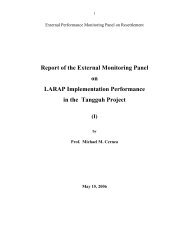
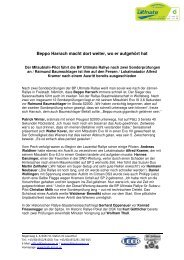
![[PDF] Deepwater Horizon: Accident Investigation Report - BP](https://img.yumpu.com/51697031/1/190x245/pdf-deepwater-horizon-accident-investigation-report-bp.jpg?quality=85)
